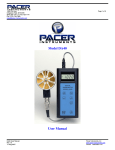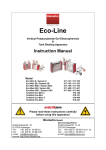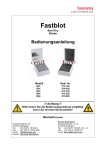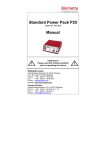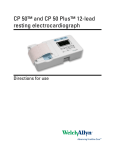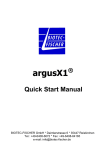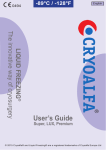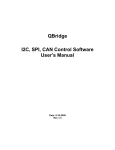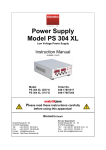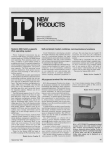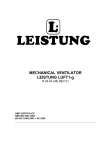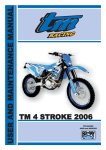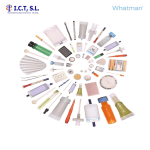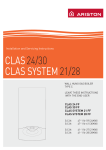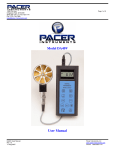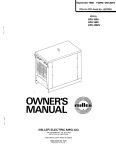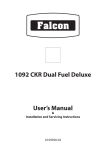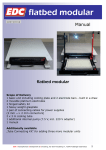Download Fastblot user manual (English)
Transcript
Fastblot Semi-Dry Electrophoretic Transfer Apparatus Instruction Manual Model Order No B33 B34 B43 B44 B64 014-100 014-200 015-100 015-200 015-600 !! Warning !! Please read these instructions carefully before using this apparatus! Biometra GmbH Rudolf-Wissell-Str. 30 D-37079 Goettingen Tel: +49 (0)5 51 50 68 6-0 Fax: +49 (0)5 51 50 68 6-66 e-mail: [email protected] internet: http://www.biometra.de Service Department Rudolf-Wissell-Str. 14-16 D-37079 Goettingen Tel.: +49 (0)5 51 50 68 6-10 or -12 Fax.: +49 (0)5 51 50 68 6-11 e-mail: [email protected] This document describes the state at the time of publishing. It needs not necessarily agree with future versions. Subject to change! Fastblot Instruction Manual, 2009/07 Contents: 1 2 3 Introduction...................................................................................................................... 3 1.1 Field of Application...................................................................................................... 3 1.2 Specifications .............................................................................................................. 4 1.3 Legal Notes ................................................................................................................. 5 1.4 Meaning of the Instructions ......................................................................................... 5 Safety and Warning Notices ........................................................................................... 6 2.1 Definition of Symbols .................................................................................................. 6 2.2 General Safety Instructions ......................................................................................... 6 Setting-Up Operation....................................................................................................... 9 3.1 Scope of Delivery ........................................................................................................ 9 3.2 Unpack and Check ...................................................................................................... 9 3.3 Installation Conditions ................................................................................................. 9 3.4 Connecting Conditions ................................................................................................ 9 4 Operating Elements / Controls ..................................................................................... 10 5 Operating........................................................................................................................ 11 5.1 Protein Blotting.......................................................................................................... 11 5.1.1 Preparing a Blotting Sandwich............................................................................11 5.1.2 Using a Discontinuous Buffer System ................................................................14 5.2 DNA Blotting (Agarose Gels)..................................................................................... 16 5.2.1 5.3 6 7 8 Sample Preparation: ...........................................................................................16 Stacked-Gel transfer ................................................................................................. 16 General Blotting Information ........................................................................................ 17 6.1 Efficiency of the Transfer .......................................................................................... 17 6.2 Nitrocellolose Blotting Membranes............................................................................ 17 6.3 Blotting Conditions .................................................................................................... 17 6.4 Cooling ...................................................................................................................... 18 Buffers and Staining/Destaining Solutions................................................................. 19 7.1 Continuous Buffer Systems:...................................................................................... 19 7.2 Discontiuous Buffer Systems: ................................................................................... 20 7.3 Notes for blotting using Methanol / SDS: .................................................................. 20 7.4 Buffers for DNA transfer: ........................................................................................... 21 7.5 Staining and Destaining solutions: ............................................................................ 21 Trouble Shooting ........................................................................................................... 22 Fastblot Instruction Manual, 2009/07 1 9 Product Information ...................................................................................................... 23 10 References .................................................................................................................. 24 11 Maintenance and Repair ............................................................................................ 25 11.1 Cleaning and Maintenance .................................................................................... 25 11.2 Servicing ................................................................................................................ 25 11.3 Replacement of Spare Parts.................................................................................. 25 11.4 Other Accessories.................................................................................................. 25 12 Service......................................................................................................................... 26 12.1 Instructions for return shipment ............................................................................. 26 13 Equipment Decontamination Certificate .................................................................. 27 14 Note for Disposal of Electric/Electronic Waste ....................................................... 29 15 EC – Declaration of Conformity / EU - Konformitätserklärung............................. 30 16 Warranty ...................................................................................................................... 31 2 Fastblot Instruction Manual, 2009/07 1 Introduction 1.1 Field of Application The Biometra Fastblot is intended to be used for electroblotting in laboratoryies. Electroblotting has become an important method transfering proteins from polyacrylamide gels onto nitrocellulose, nylon or other membranes.¹,²,³ Conventional blotting (tank blotting) is performed in a big buffer chamber and the procedure is very buffer and time consuming. The more recent method of semi-dry blotting between carbon plate electrodes allows a more rapid and homogeneous transfer.4 Pure (unmodified) carbon plates originally used for semi-dry blotting show extensive corrosion and decomposition. The electrodes used for the Fastblots B33, B34 and B64 are made of special modified carbon based material. The electrodes used for Fastblot B43 and B44 are made of special modified metal. All this materials are extremely resistant and allow transfer at higher currents. Transfers are usually completed within 10 to 30 minutes and are uniform in all areas of the polyacrylamide gel. With the semi-dry blotting procedure even high molecular weight proteins (> 100 kDa) are transferred from (SDS-)polyacrylamide gels to a membrane at high currents. The Fastblot is available in two different sizes: 16 cm x 20 cm and 23.5 cm x 28.5 cm electrode surface. The size 16 cm x 20 cm is available with or without internal cooling. The large size includes a paasive cooling option. Warming up of the apparatus and blot-sandwich during the transfer at high current conditions or during blotting of native proteins can be compensated by the internal cooling system of the Fastblot B33 or B43. B43/B44 B33/B34 Fastblot Instruction Manual, 2009/07 B64 3 1.2 Specifications Construction Fastblot body Anode Cathode PMMA B33, B34; B64: Plasticised carbon B43, B44: Platinum-coated titanium B33, B34, B64: Plasticised carbon B43, B44: Stainless steel Cooling option B33, B43: flow through Overall size (L x W xH) B33, B43: B34, B44: B64: 26 cm x 22 cm x 11 cm 24 cm x 22 cm x 11 cm 34 cm x 44 cm x 14 cm Weight B33, B34: B43, B44: B 64: ~ 2 kg ~ 2.5 kg ~ 6 kg Maximum gel size B33, B34, B43, B44: 15.5 cm x 19.5 cm B64: 23 cm x 38 cm Chemical compatibility The semi-dry blotter components are not compatible with alcohol >10% (e.g. methanol, ethanol) or organic solvents (e.g. acetone, chloroform, toluene, benzene). Use of organic solvents voids all warranties. The instrument is designed for operation in closed laboratory rooms at ambient temperature from +5 °C to +40 °C and maximum relative humidity 80% for temperatures up to +31 °C decreasing linearly to 50% relative humidity at +40 °C. 4 Fastblot Instruction Manual, 2009/07 1.3 Legal Notes Copyright All rights reserved. It is not allowed to copy and publish the manual or parts of it in any form as copies, micro film or other methods without a written authorisation from Biometra. Biometra is pointing out that applied company and brand names are usually protected trade marks. Liability Biometra is not liable for damages and injuries caused by use not considering these operatin instructions in parts or completely. 1.4 Meaning of the Instructions Biometra recommends that you first read these instructions carefully. Then assemble and disassemble the apparatus to become familiar with the system. After these preliminary steps, you should be ready to transfer a sample. This operaton instruction is part of the product and should be kept over the full life-time of the instrument. It should also be forwarded to subsequent owners and users. Make sure that additions and updates are inserted into the operation instructions. Fastblot Instruction Manual, 2009/07 5 2 Safety and Warning Notices 2.1 Definition of Symbols Symbol Definition Caution! Refer to instruction manual! Danger! High voltage! Fragile! Using with direct current (DC). 2.2 General Safety Instructions Delicate instuments! Handle with care! Do not operate this equipment if buffer or water leaks from the instrument, if cracks are present in the body or the safety cover or if the electrical connection cables are worn or frayed. Make sure that the on/off switch of the used external Power Supply is always free accessible. Danger! High voltage! The current to the cell, provided from the external Power Supply, enters the unit through the lid assembly, providing a safety interlock to the user. Current to the cell is broken when the lid is removed. Do not attempt to circumvent this safety interlock, and always turn the Power Supply off before removing the lid, or when working with the cell in any way. 6 Fastblot Instruction Manual, 2009/07 Power to the instrument is supplied by an external DC voltage Power Supply. The output of this Power Supply must be isolated from external ground to issue that the DC voltage output floats with respect to ground. (All Biometra Power Supplies meet this safety requirement!) Never place the instrument on top of a Power Supply. Do not reverse polarity of the electrodes: The anode (+) is on the body of the Fastblot and the cathode (-) is fixed in the lid ! Change of polarity will result in corrosion and rusting of the stainless steel cathode or damage (e.g. bubbling) of the plasticised carbon electrodes. Using the cooling option do not mix up the "in" and "out" plugs for the cooling water. The connection for the water cooling with the smaller diameter is the inlet the connection with the bigger diameter is the outlet. Best cooling is obtained using a refrigerated circulator (chiller) with a temperature of 5°C. (Attention: Reduce flow rate to max. 1 l/min and use no organic solvents or alcohol !) Operating Conditions: B33 Parameter B34 B43 B44 B64 50 V Max. Voltage Max. Current / cm2 gel 5 mA 3.5 mA 8W 10 W Max. Power 50 °C Max. Temperature pH 3 - 10 pH Range (Electrodes) Max. Flow Rate of Cooling Water (l / min), Unpressurised 0.5 - 1 n. A. 0.5 - 1 pH 3 - 9 n. A. n. A. Lengthy transfer times are not recommended. Do not leave the instrument unattended. Joule heat can be generated rapidly during semi-dry blotting. Transferring longer than 2 hours can damage the unit. Fastblot Instruction Manual, 2009/07 7 Do not adjust the pH of transfer buffers unless specifically indicated. Follow the instructions carefully. Adjustment of pH of transfer buffers, when not indicated, will result in increased buffer conductivity. This is manifested by a higher than expected initial current output as shown by the power supply's current meter. Do not use alcohol (e.g. methanol, ethanol) or organic solvents for cooling or cleaning the apparatus. This products are designed and certified to meet EN 61010-1 safety standards. Certified products are safe to use when operated in accordance with the instruction manual. This instruments should not be modified or altered in any way. Alteration of this instruments will void the warranty, void the EN61010-1 certification, and create a potential safety hazard. 8 Fastblot Instruction Manual, 2009/07 3 Setting-Up Operation 3.1 Scope of Delivery The Fastblot comes complete with: - Body with electrode (anode) - B33, B43: including cooling device - Lid with electrode (cathode) - Wires (permanently attached to the lid) with safety connectors - Warranty Registration card - Manual 3.2 Unpack and Check Unpack and carefully examine the Fastblot. Report any damage to BIOMETRA. Do not attempt to operate this device if physical damage is present. Please keep the original packing material for return shipment in case of service issues !! Attention !! Please fill out and send back the warranty registration card. This is important for you to claim full warranty. 3.3 Installation Conditions Place the chamber in proximity to the Power Pack with which it is to be connected. Be sure to place the chamber in a safe, dry location away from the edge of the working surface. 3.4 Connecting Conditions The Fastblot has been designed to operate with D.C. current. Warning: The Fastblot must not be earthed. Fastblot Instruction Manual, 2009/07 9 4 Operating Elements / Controls Stainless steel cathode Connection for flow-through cooling (reflected in cathode) Safety interlock Platinum-coated titanium anode Safety distance pieces Plasticised carbonl cathode Plasticised carbon anode 10 Fastblot Instruction Manual, 2009/07 5 Operating 5.1 Protein Blotting To determine the optimum conditions for a particular sample, a time course of transfer should be performed. Since many factors affect transfer e.g. molecular weight, pI, and porosity of the gel, transferring for the full suggested time may not be necessary. 5.1.1 Preparing a Blotting Sandwich Step 1: After finishing the electrophoresis immediately remove the gel from the glass plates and cut out from the gel the part you want to blot. Attention: Wear gloves ! Step 2: Cut the blotting paper to the gel size and soak five (5) layers of 0.34 mm thick Blotting paper (Whatman 3MM Chr) or three (3) layers of 0.92 mm thick Blotting paper (Whatman 17Chr) or two (2) layers of 1.2 mm thick Blotting paper (Whatman GB005) with transfer buffer. Place the soaked filter paper on the anode (+). The anode is the plate electrode on the body of the Fastblot. Step 3: Cut the membrane (usually nitrocellulose) carefully to gel size, prewet it with buffer for 5 min. and place it on the filter paper prepared in step 2. A PVDF membrane has to be successively incubated in methanol (1 – 2 seconds), in H2O (5 minutes) and in transfer buffer prior to use. (Using a discontinuous buffer system the gel has to be preweted in anode buffer II.) Attention: Avoid the inclusion of air bubbles (“white spots“ on the membrane) and wear gloves when handling the membrane ! Step 4: Equilibrate the gel in transfer buffer for 5 min. (Using as discontinous buffer system the gel has to be equilibrated in the cathode transfer buffer.) Attention: Gel equilibration time has to be consistent. Shortened or extended times may affect transfer efficiencies. Step 5: Place the SDS-polyacrylamide gel on top of the membrane. Attention: Avoid air bubbles ! Fastblot Instruction Manual, 2009/07 11 Step 6: Add five (5) layers of 0.34 mm thick Blotting paper (Whatman 3MM Chr) or three (3) layers of 0.92 mm thick Blotting paper (Whatman 17Chr) or two (2) layers of 1.2 mm thick Blotting paper (Whatman GB005) previously soaked with transfer buffer on top of the polyacrylamide gel. DO NOT use acidic transfer buffers pH < 3 or alkaline transfer buffers pH > 9 (B64) resp. pH > 10! Step 7: Remove air bubbles which might be included by carefully rolling out the blot-sandwich with a tube or a pipette. Step 8: Connect the lid with the body of the Fastblot. Take care that lid and body are attached completely horizontally. When handling thicker gels put a weight of 1 - 2 kg on top of the lid (e.g. a beaker glass with cold water). Step 9: If you have assembled the “sandwich“ for blotting, the set up should look as shown in Fig. 2. Fig. 2: Set up of filter paper (blotting paper), gel and blotting membrane between the plate electrodes. Blotting paper and blotting membrane are used in the same size as the gel. Step 10: Switch on your Power Supply, e.g. Biometra Standard Power Pack P25 (Code-No. 040-800 or 048-850) or one of the Biometra High Voltage Power Packs at a constant current of 0.8 – 1.0 mA per cm2 of gel (max. 3.5 mA per cm² of gel (B64) resp. max. 5 mA per cm² of gel). Typical blotting times are approx. 30 min. Smaller molecules might be transferred within 5 min. (depending on the charge). Attention: The maximum power for the B33, B34, B43 and B44 is 8 Watts (W) resp. 10 W (B64). The electrodes consist of different materials. DO NOT change polarity of the electrodes: The anode (+) is on the body of the Fastblot and the cathode (-) is fixed on the lid ! 12 Fastblot Instruction Manual, 2009/07 Step 11: If the lid is getting warm during the blot procedure reduce the current. The maximum temperature must not exceed 50°C! Step 12: If you are using the water cooling, please note the following: The connection for the water cooling with the smaller diameter is the inlet, the connection with the bigger diameter is the outlet. Attention: Never mix up inlet and outlet ! The cooling water flow should be max. 0.5 - 1.0 l / min (unpressurised). Use no organic solvents or alcohol ! Best cooling is obtained using a refrigerated circulator (chiller) (e.g. Code-No. 043-300 or 043-390) with a temperature of 5°C. (Attention: Reduce flow rate to max. 1 l/min) Step 13: After finishing the blot transfer switch off the current first, disconnect Power Supply and Fastblot and turn off the cooling water. After this take off the lid! Danger! High voltage! Never try to detach the cables from the lid and never open the system during blotting! Step 14: Remove the blot-sandwich carefully and take the membrane out of the “sandwich”. Then proceed with staining or immunoassay. Never touch the membrane with fingers (without gloves)! Step 15: After every blotting procedure clean the plate electrodes with distilled water. A paper towel can be used for drying. Never use any organic solvent for cleaning carbon electrodes or housing! Fastblot Instruction Manual, 2009/07 13 5.1.2 Using a Discontinuous Buffer System The use of discontinuous buffer systems allows a higher resolution of the proteins and the transfer kinetics can be improved. The method essentially resembles the blotting with continuous buffer system. The main difference is that 3 different buffers are used. (For detail refer to chapter 7.) Step 1: After the electrophoresis incubate the gel in cathode buffer for five minutes. Step 2: Moisten the anode with anode buffer I. Step 3: Cut blotting paper to the size of the gel. Step 4: Soak blotting paper in anode buffer I and place them on the anode. Step 5: A further layer of the adapted blotting paper is soaked with the anode buffer II and added to the sandwich. Step 6: Pre-wet the membrane (Nitrocellulose) cut to the size of the gel with anode buffer II. PVDF membranes have to be successively incubated in methanol (1 – 2 seconds), in H2O (5 minutes) and in anode buffer II. Subsequently, the membrane is placed on the transfer sandwich. Step 7: The SDS-Polyacrylamide gel is put on top of the membrane. Step 8: Three layers of blotting paper are soaked in cathode buffer and placed on top of the gel. Note: Avoid the inclusion of air bubbles in the blotting sandwich and wear gloves! Step 9: Connect the lid with the body of the Fastblot. Take care that lid and body are attached completely horizontally. Step 10: If you have assembled the “sandwich“ for blotting, the set up should look as shown in Fig. 3. 14 Fastblot Instruction Manual, 2009/07 Fig. 3: Set up of filter paper (blotting paper), gel and blotting membrane between the plate electrodes. Blotting paper and blotting membrane are used in the same size as the gel. For the further proceedings please refer to chapter ”5.1.1 Preparing a Blotting Sandwich”. Fastblot Instruction Manual, 2009/07 15 5.2 DNA Blotting (Agarose Gels) Using the Fastblot also nucleic acids can be transferred to membranes. (Nevertheless the use of a Vac-Blot System (Code No. 053-000 and 053-300) is recommended.) 5.2.1 Sample Preparation: Prior to the transfer, the DNA should be pre-treated in order to increase the efficiency of the blotting. Depurination 0.25 M HCl 7 min Denaturation 0.5 M NaOH 1.5 M NaCl 15 min Neutralisation 3.0 M NaCl 0.5 M Tris, pH 7.4 15 min Build up the blotting sandwich as described in chapter Fehler! Verweisquelle konnte nicht gefunden werden., but use 1 x TAE or 1 x TBE as transfer buffer and 10 layers of 0.34 mm thick blotting paper (Whatman 3MM Chr paper, Code No. 3030700, 3030704, 3030861, 3030917 and 3030931) or 4 layers of 1.2 mm thick blotting paper (Whatman GB005, Code No. 10426981, 10426994) on either side of the membrane/gel-sandwich. For the transfer of DNA, the membrane (e.g. nylon) has to be on the anode side of the gel. Using 3 – 5 mA per cm² of gel the transfer takes about 30 minutes. Do not use nitrocellulose membranes, because they are not stable in basic solutions! For the further proceedings please refer to chapter ”5.1.1 Preparing a Blotting Sandwich”. 5.3 Stacked-Gel transfer Two-layer transfer can be performed in the Fastblot B64 and up to four-layer transfer can be performed in the Fastblot B33, B34, B43 and B44. The use of dialysis membranes between the layers is recommended may not be neccessary. Prepare gels, membranes and blotting paper as described above (using continuous buffer systems!). When setting up the transfer stack, place pre-wetted blotting paper on top of the first gel, followed by the second membrane, second gel, paper ....... and then the cathode lid. Measure the surface area of the top of the stack to determine proper current. 16 Fastblot Instruction Manual, 2009/07 6 General Blotting Information 6.1 Efficiency of the Transfer The efficiency of the transfer can be checked by applying Coomassie blue prestained standard proteins on the gel. After the blotting it is possible to stain the gel with Coomassie blue to check the completeness of transfer. 6.2 Nitrocellolose Blotting Membranes High Quality Nitrocellulose membranes are standard for protein- and nucleic acid blotting. They can easily be stained for total protein by a dye stain (e.g. Amido Black, Coomassieblue, Ponceau S, Fast Green, etc.). Nitrocellulose has a high binding capacity of apprx. 80–90 µg/cm². Unspecific protein binding sites are easily and rapidly blocked, avoiding subsequent background problems. Small proteins (esp. < 20,000 daltons) may be lost during washing steps after the transfer. Use of a smaller pore size nitrocellulose membrane (0.2 µm) will eliminate this loss. Large proteins (>100,000 daltons) denatured by SDS may transfer poorly with the addition of alcohol to the transfer buffer. Alcohol increases binding of SDS-proteins to nitrocellulose, but decreases pore sizes in the gel. Elimination of alcohol from SDS-protein transfers also results in considerably diminished binding to nitrocellulose. Because of the high field strength during the blotting process, proteins may be transferred through the nitrocellulose membrane without binding. The efficiency of binding can be increased by employing a smaller pore size nitrocellulose. 6.3 Blotting Conditions The blotting conditions (time, current) should be optimised for every protein. Time and transfer rates of different proteins are summarised in Figure 1. Using the plot shown in Fig. 1 it is possible to carry out a rough estimation of the transfer times. • The transfer time is also influenced by the thickness and the acrylamide concentration of the gel. • If the transfer time is too long the protein may pass through the blotting membrane and is lost. You can check this by adding another layer of membrane and check the second membrane also for protein after blotting. Fastblot Instruction Manual, 2009/07 17 Fig.1: Electrophoretic transfer of proteins. SDS-PAGE, Acrylamide concentration: 10%; Nitrocellulose blotting membrane, pore size 0.45 µm; current: 5 mA per cm2 gel; thickness of gel: 1.0 mm; transfer buffer: Tris/Glycine/SDS Using B43/B44 may reduce the transfer time in the range of 10 - 20%. 6.4 Cooling When blotting high molecular weight proteins (> 100 kDa) blotting will take up to 30 min. In this case or when blotting native proteins/enzymes, we suggest using the cooling system of the Fastblot B33 or B43. 18 Fastblot Instruction Manual, 2009/07 7 Buffers and Staining/Destaining Solutions 7.1 Continuous Buffer Systems: Transfer buffer, pH 8.3 25 mM Tris-base 150 mM Glycine 10 % Methanol Optional: Dilute the electrophoresis running buffer with one or two volumes of distilled water and add 10-20% Methanol. Running buffer (Laemmli System): 25 mM Tris-base 192 mM Glycine 0.1 % SDS (Sodiumdodecylsulphate) For blotting dilute with one or two volumes distilled water! Towbin buffer: 50 96 pH mM Tris mM Glycine 7.8 - 8.4 Max. Amperage for use with Fastblot B64 = 3.5 mA/cm2 gel Fastblot Instruction Manual, 2009/07 19 7.2 Discontiuous Buffer Systems: Anode buffer I: 300 20 mM % (v/v) Tris/HCl, pH 10,4 Methanol Anode buffer II: 25 20 mM % (v/v) Tris/HCl, pH 10,4 Methanol Cathode buffer: 25 40 20 0.01 % mM mM % (v/v) SDS Tris/HCl, pH 9,4 Capronic acid Methanol alternative Cathode buffer: 40 mM D, L-norleucine 25 mM Tris/HCl, pH 9.4 (Dissolve norleucine with warming. Stock solutions of norleucine cannot be prepared due to the limited solubility!) 20 % Methanol Max. Amperage for use with Fastblot B64 = 2.5 mA/cm2 gel 7.3 Notes for blotting using Methanol / SDS: Methanol: max. 20% (v/v) enhances binding of proteins to nitrocellulose reduces gel swelling may reduce solubility of proteins (in this case proteins are transferred less efficiently) SDS: max 1% (w/v) ensures homogeneous negative charge of proteins may change antigenic properties of proteins may reduce binding of protein to the emebrane 20 Fastblot Instruction Manual, 2009/07 7.4 Buffers for DNA transfer: 50 x TAE-Buffer-Stock (1 Liter): 242 g 57,1 ml 100 ml Tris base, pH 8,0 Glacial acetic acid EDTA (0,5 M) 5 x TBE-Buffer-Stock (1 Liter): 54 g 27,5 g 20 ml Tris base, pH 8,0 Boric acid EDTA (0,5 M) 7.5 Staining and Destaining solutions: Staining Solution (1 litre) 2.0 g Coomassie Brilliant Blue R 250 0.5 g Coomassie Brilliant Blue G 250 425 ml Ethanol 50 ml Methanol 100 ml Acetic acid 425 ml bidest. water Stir overnight; filtrate before use; store in dark bottle! Destaining solutions (acrylamide gels) Fast destaining in: 45 % 10 % 45 % Ethanol Acetic acid bidest. water Slow destaining in: 25 % 10 % 65 % Isopropanol Glacial acid bidest. water Final destaining in: 7 % Acetic acid in bidest. water Fastblot Instruction Manual, 2009/07 21 8 Trouble Shooting Problem Cause No transfer Wrong order of membrane and Reverse order of membrane gel and gel: gel on top of membrane Wrong connection to the Power Cexchange connection: Supply Red = anode (+) Black = cathode (-) Acidic buufer system: transfer Place transfer membranes on towards cathode! cathode side (lid) and gel on anode side (base) Transfer time too short (check by Increase trander time gel staining) Tranfer time too long: "blow Reduce transfer time. Use through" (i.e. proteins are nitrocellulose with smaller stained on both sides of the pore size or PVDF membrane mebrane) Air bubbles in the blot sandwich Remove air bubbles by gently rolling e.g. a pasteur pipette over the emebrane Generation of air bubbles with Reduce transfer time, chill long transfer times by buffer before use. electrolysis and heating up Irregular current flow as size of Transfer membranes and blotting papers and transfer blotting papers must be cut emebrane are large than gel size exactly to gel size Blotting paper partially dried Reduce transfer time Insufficiently soaked transfer Check procedure for membrane prewetting membrane Spoiled electrodes Clean electrodes Transfer time to long: "blow Reduce transfer time. Use through" nitrocellulose with smaller pore size or PVDF membrane Power Supply does not work at Use proper Power Supply low voltages (inner resistance which can operate at low voltages (e.g. Standard too high) Power Pack P25) Blot sandwich dries out Reduce amperage (soak blotting paper cuts with more transfer buffer) Generation of air bubbles ont the Chill buffers before use / elctrodes by electrolysis Reduce transfer time Insufficiently soaked transfer Check procedure for membrane prewetting membrane Amperage too high Reduce amperage / Reduce transfer time Transfer time too long Chill buffers before use / Reduce transfer time Conductivity of buffer too high Check transfer buffers / Use buufers described in this manual Incomplete transfer Irregular transfer Proteins are stained on both sides of the membrane Power Supply turns off Strong increase of voltage during transfer Intensive heating up 22 Fastblot Instruction Manual, 2009/07 Corrective Actions 9 014-100 014-200 015-100 015-200 015-600 Product Information Fastblot B33, complete system, electrode surface 16 cm x 20 cm, with flow-through cooling, incl. manual Fastblot B34, complete system, electrode surface 16 cm x 20 cm, without cooling, incl. manual Fastblot B43, complete system with special metal electrodes (platinum coated titan anode and stainless steel cathode), electrode surface 16 cm x 20 cm, with flow-through cooling, incl. manual Fastblot B44, complete system with special metal electrodes (platinum coated titan anode and stainless steel cathode), electrode surface 16 cm x 20 cm, without cooling, incl. manual Fastblot B64, complete system, electrode surface 23.5 cm x 38.5 cm, passive cooling, incl. manual Blotting Paper: 10 426 981 10 426 994 Whatman GB005, 200 mm x 200 mm, 1.2 mm thick, 25 sheets Whatman GB005, 580 mm x 580 mm, 1.2 mm thick, 25 sheets 3017915 3030 931 Whatman 17Chr, 460 mm x 570 mm, 0.92 mm thick, 100 sheets Whatman 3MM, 580 mm x 680 mm cm, 0.34 mm thick, 100 sheets Nitrocellulose Blotting Membranes: 10 401 396 Whatman Protran-BA83, Pore size 0.20 µm, 30 cm x 3 m roll 10 401 196 10 401 180 10 402 580 Whatman Protran-BA85, Pore size 0.45 µm, 30 cm x 3 m roll Whatman Protran-BA85, Pore size 0.45 µm, 30 cm x 60 cm, 5 sheets/pack Whatman Protran-BA85, Pore size 0.45 µm, 33 cm x 56 cm, 5 sheets/pack 10 439 196 Whatman Protran-BA-S 85, Pore size 0.45 µm, 30 cm x 3 m roll Fastblot Instruction Manual, 2009/07 23 10 References 1. Towbin, H., Staehlin, T. and Gordon, J. (1979); Proc. Nat. Acad. Sci. 76, 4350 - 4356 2. Bittner, M., Kupferer, P. and Morris, C.F. (1980); Anal. Biochem. 102, 459 - 571 3. Burnette, W.N. (1981); Anal. Biochem. 112, 195 - 203 4. Kyse-Andersen, J. (1984); J. Biochem. Biophys. Meth. 10, 203 – 209 24 Fastblot Instruction Manual, 2009/07 11 Maintenance and Repair 11.1 Cleaning and Maintenance Do not immerse the unit in liquid. Use special care when cleaning the anode plate of B43, B44 to avoid scratching or marring the platinum. Do not use abrasives or strong detergents. The cathode plate (stainless steel) of B43, B44 can be cleaned with a mild abrasive to remove salt that may deposit during normal operation. The entire unit can also be periodically disassembled and cleaned with (warm) water to remove salt deposits. Do not use alcohol >10% (e.g. methanol, ethanol) or organic solvents (e.g. acetone) for cleaning of electrodes or housing. The system should never be autoclaved or placed in a microwave. 11.2 Servicing Regular servicing is not necessary. Nevertheless cleaning of the electrodes should be done using a damp cloth wetted with dest. water after each transfer. In case that the electrodes are clogged after longer time of use and the blotting transfer is inhomogeneous or reduced, please contact the Biometra Service Department. 11.3 Replacement of Spare Parts Only original spare parts mentioned in these operating instructions are allowed. 11.4 Other Accessories There are no accessory parts for this instruments. Fastblot Instruction Manual, 2009/07 25 12 Service Should you have any problems with this unit, please contact our service department or your local Biometra dealer: Biometra GmbH Service Department Rudolf-Wissell-Straße 14 - 16 D-37079 Goettingen Phone: +49 (0)5 51 50 68 6 - 10 or 12 Fax: +49 (0)5 51 50 68 6 -11 e-mail: [email protected] If you would like to send the unit back to us, please read the following return instructions. 12.1 Instructions for return shipment • Return only defective devices. For technical problems which are not definitively recognisable as device faults please contact the Technical Service Department at Biometra (Tel.: +49 (0)5 51-50 88 1-10 or -12, Fax: +49 (0)5 51-50 88 1-11, e-mail: [email protected]). • Please contact our service department for providing a return authorization number (RAN). This number has to be applied clearly visible to the outer box. Returns without the RAN will be not be accepted! • Important: Carefully clean all parts of the instrument from residues, and of biologically dangerous, chemical or radioactive contaminants. If an instrument is contaminated, Biometra will be forced to refuse to accept the device. The sender of the repair order will be held liable for possible damages and losses resulting from insufficient decontamination of the device. • Please prepare written confirmation (use the “Equipment Decontamination Declaration” following on the next page) that the device is free of biologically dangerous, chemical or radioactive contaminants. This confirmation must be attached to the outside of the packaging. • Use the original packing or a similarly robust packing when returning the device. If not available, contact Biometra or your local distributor. • Label the outside of the box with “CAUTION! SENSITIVE INSTRUMENT!” and the RAN number sticker. Attach the Decontamination Declarartion! • Please enclose a note which contains the following: a) Sender’s name and address, b) Name of a contact person for further inquiries with telephone number. c) Precise description of the fault, which also reveals during which procedures the fault occurred, if possible. 26 Fastblot Instruction Manual, 2009/07 13 Equipment Decontamination Certificate To enable us to comply with german law (i.e. §71 StrlSchV, §17 GefStoffV and §19 ChemG) and to avoid exposure to hazardous materials during handling or repair, please complete this form, prior to the equipment leaving your laboratory. COMPANY / INSTITUTE __________________________________________________ ADDRESS ______________________________________________________________ PHONE NO _________________________ E-MAIL ______________________________________________________________ EQUIPMENT FAX NO_________________________ Model ______________ Serial No ______________ ______________ ______________ ______________ ______________ ______________ ______________ If on loan / evaluation Start Date: __________________ Finish Date __________________ Hazardous materials used with this equipment: __________________________________________________________________________ __________________________________________________________________________ __________________________________________________________________________ Method of cleaning / decontamination: __________________________________________________________________________ __________________________________________________________________________ __________________________________________________________________________ The equipment has been cleaned and decontaminated: NAME __________________________________ POSITION _______________________ (HEAD OF DIV./ DEP./ INSTITUTE / COMPANY) SIGNED ________________________________ DATE ____________________________ PLEASE RETURN THIS FORM TO BIOMETRA GMBH OR YOUR LOCAL BIOMETRA DISTRIBUTOR TOGETHER WITH THE EQUIPMENT. PLEASE ATTACH THIS CERTIFICATE OUTSIDE THE PACKAGING. INSTRUMENTS WITHOUT THIS CERTIFICATE ATTACHED WILL BE RETURNED TO SENDER. Fastblot Instruction Manual, 2009/07 27 General Information for Decontamination: Please contact your responsible health & safety officer for details. Use of radioactive substances: Please contact your responsible person for details. Use of genetically change organism or parts of those: Please contact your responsible person for details. 28 Fastblot Instruction Manual, 2009/07 14 Note for Disposal of Electric/Electronic Waste This symbol (the crossed-out wheelie bin) means, that this product should be brought to the return systems and/or separate systems available to end-users according to yours country regulations, when this product has reached the end of its lifetime! For details, please contact your local distributor! This symbol applies only to the countries within the EEA*. *EEA = European Economics Area, comprising all EU-members plus Norway, Iceland and Liechtenstein. Fastblot Instruction Manual, 2009/07 29 15 EC – Declaration of Conformity / EU - Konformitätserklärung Goettingen, July 2009 im Sinne der EG-Richtlinie für die elektromagnetische Verträglichkeit 2004/108/EG following the EC directive about the electromagnetic compatibility 2004/108/EC Hiermit erklären wir, dass folgende Blotting Systeme Herewith we declare that the following Blotting Systems Typ / type: Fastblot B33, Fastblot B34, Fastblot B43, Fastblot B44, Fastblot B64 Best.-Nr. / Order No. 014-100, 014-200, 015-100, 015-200, 015-600 den grundlegenden Anforderungen der corresponds to the basic requirements of EG-Niederspannungsrichtlinie 2006/95/EG entsprechen. EC low voltage directive 2006/95/EC. Juergen Otte PhD Quality Manager 30 Fastblot Instruction Manual, 2009/07 16 Warranty This laboratory instrument is produced with the highest practical standards of materials, workmanship, and design. The design and manufacture of parts have been conceived with one purpose - to produce units which will give satisfactory service. Biometra GmbH guarantees this unit to be free from defects in materials or workmanship under normal use or service for 24 month from date of shipment. If, during this time, this unit proves defective in materials or workmanship, Biometra GmbH will repair or replace it free of charge if returned to us prepaid. This guarantee does not cover damage in transit, damage caused by carelessness, misuse or neglect, or unsatisfactory performance as a result of conditions beyond our control; or consequential losses as a result of failure of our product. Biometra GmbH Rudolf-Wissell-Str. 30 D-37079 Goettingen Tel: +49 (0)5 51 50 68 6-0 Fax: +49 (0)5 51 50 68 6-66 e-mail: [email protected] internet: http://www.biometra.de Service Department Rudolf-Wissell-Str. 14-16 D-37079 Goettingen Tel.: +49 (0)5 51 50 68 6-10 or -12 Fax.: +49 (0)5 51 50 68 8-11 e-mail: [email protected] Fastblot Instruction Manual, 2009/07 31

































